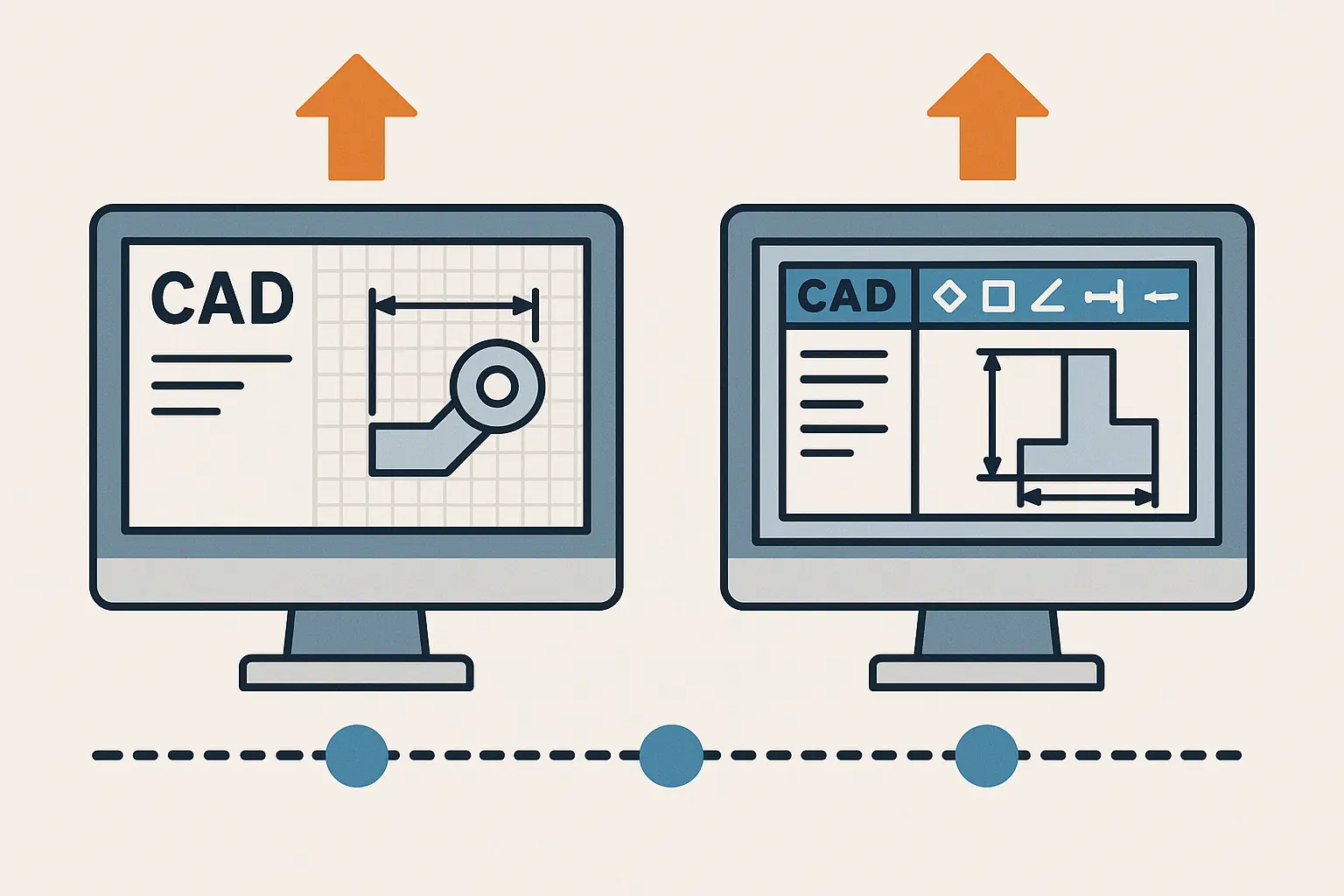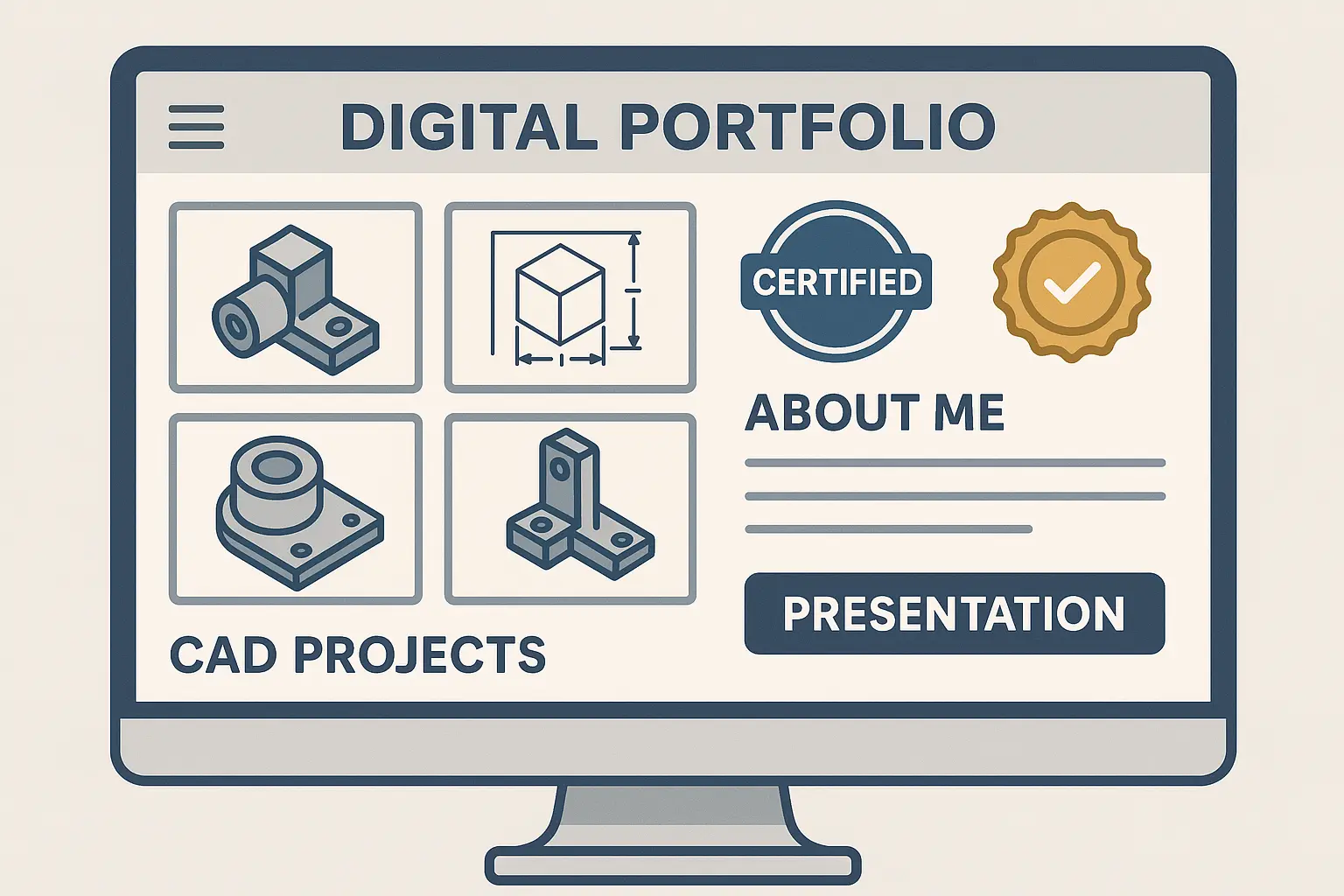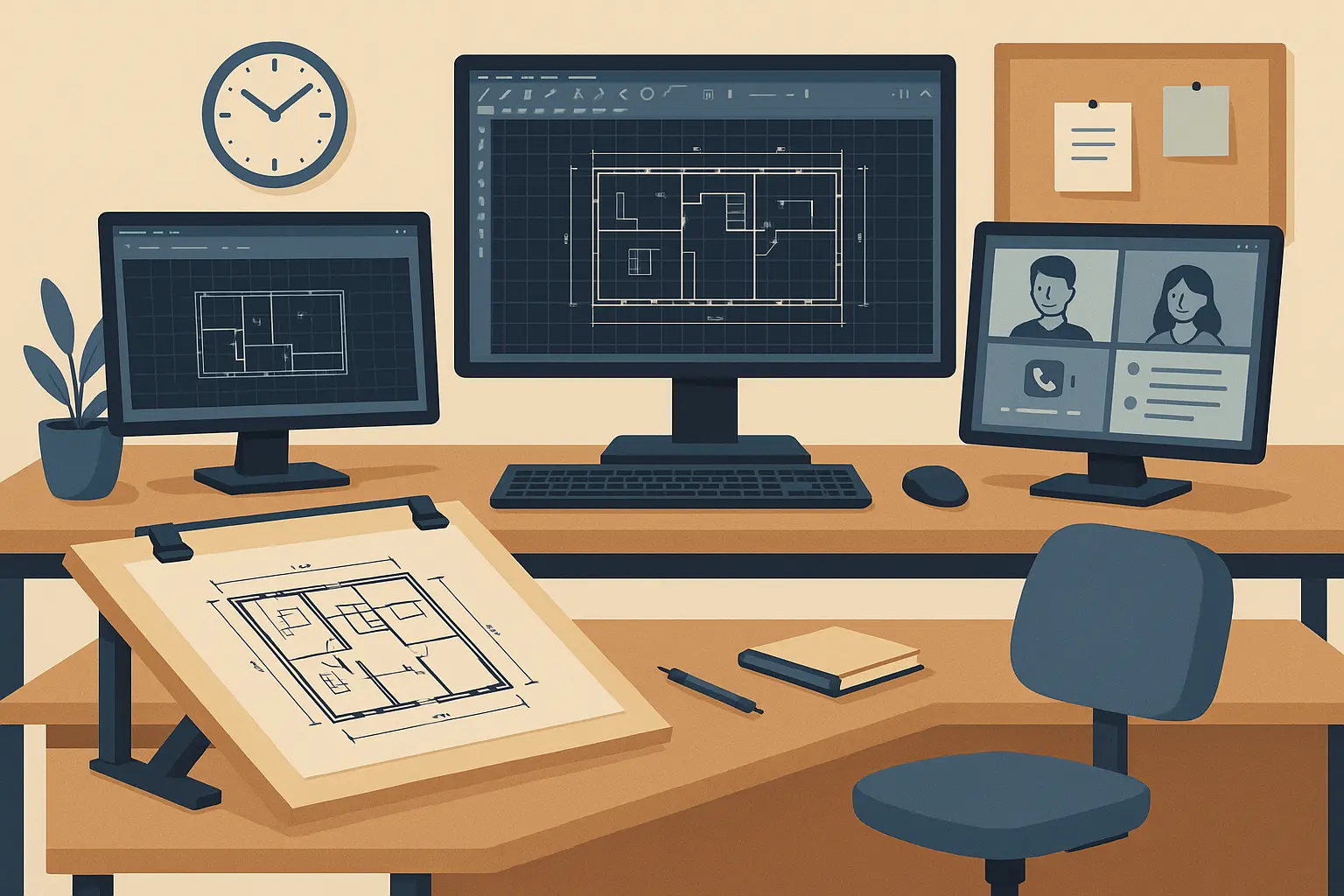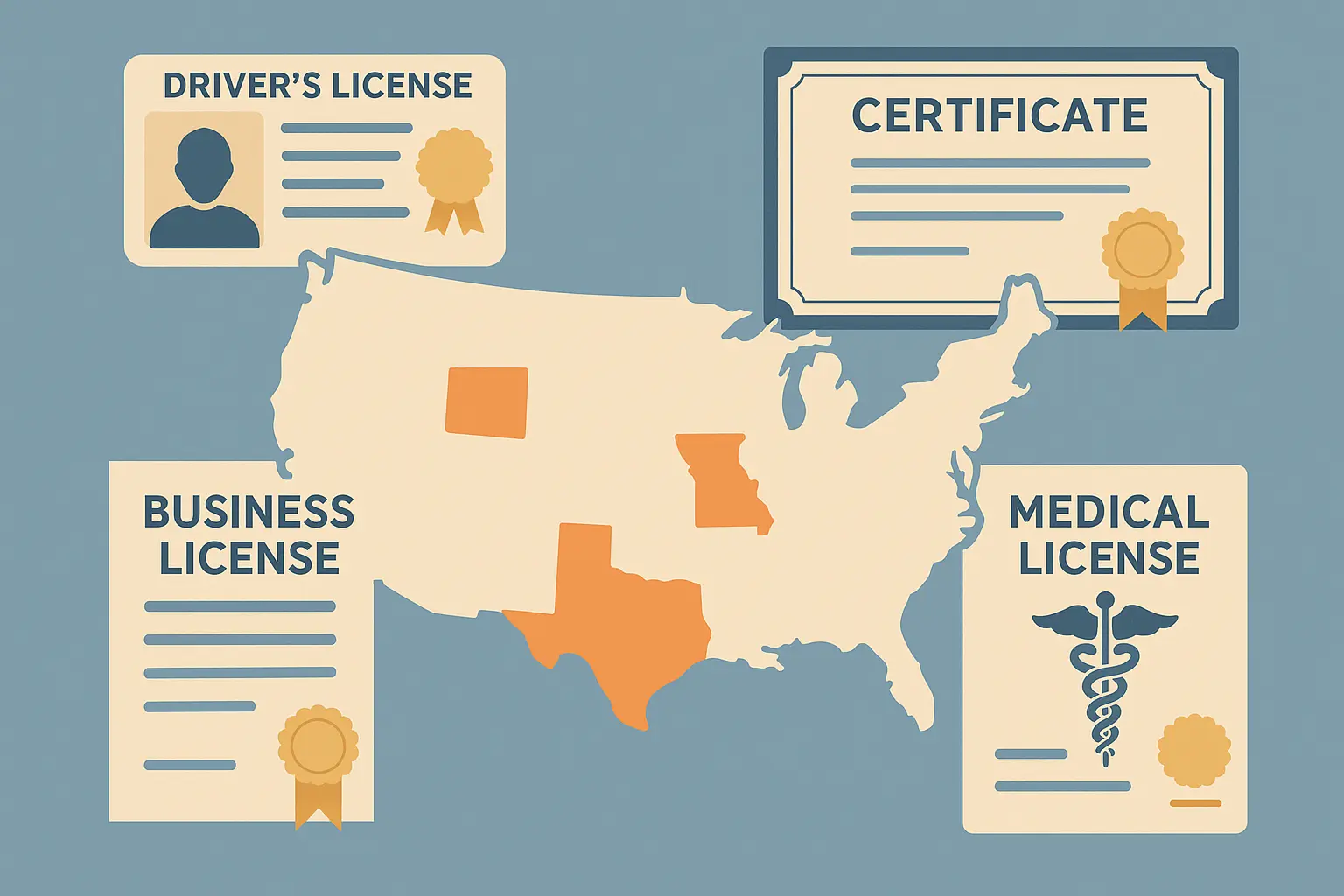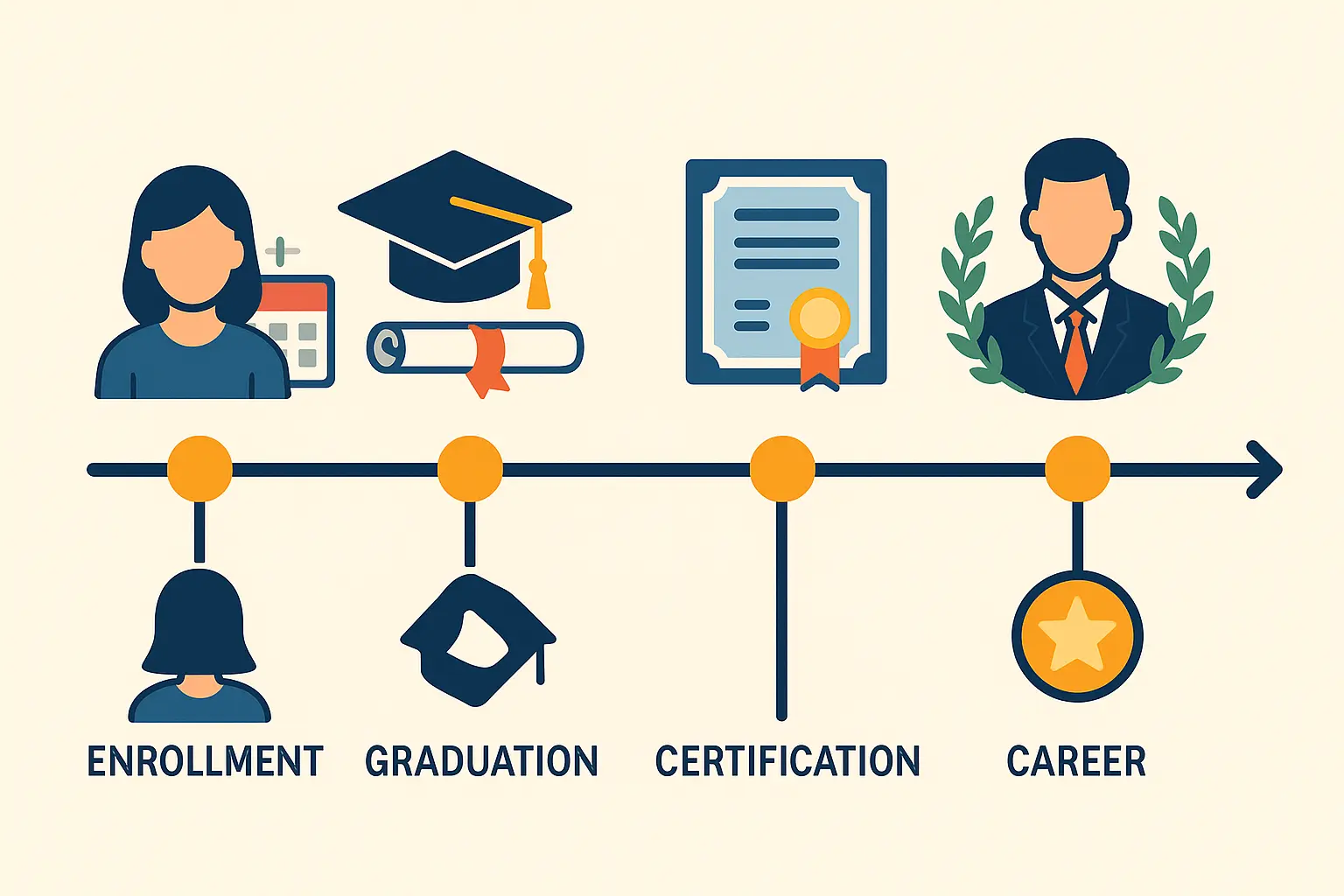When I started looking into drafting programs, I was told it would take two years. Period. But after talking to my neighbor who became a drafter in 14 months, I knew someone wasn’t telling me the whole story.
Here’s the thing nobody tells you – that traditional “two-year degree” timeline is basically marketing. After digging into this and talking to actual people working in the field, I found out completion times can range anywhere from 6 months to over 3 years depending on your approach, how much money you have, and what you’re actually trying to accomplish.
Most schools won’t tell you about the fast-track options, when you should actually start, or that awkward transition period where you’re technically graduated but still figuring out how to do the job. According to the Bureau of Labor Statistics, overall employment of drafters is projected to show little or no change from 2024 to 2034, which means you really need to be smart about how you spend your time getting trained.
Table of Contents
-
The Fast-Track Reality: Why 12 Months Beats Two Years
-
Strategic Timing: When You Start Matters More Than You Think
-
Skills-First vs. Degree-First: Alternative Pathways That Work
-
The Real Cost of Time: Financial Planning for Your Timeline
-
Beyond Graduation: The Career Transition Nobody Talks About
-
Portfolio and Certification Timelines That Actually Matter
-
Geographic and Industry Factors That Change Everything
TL;DR
-
Most drafting associate degrees can actually be finished in 12-15 months if you’re willing to hustle, not the 2 years they advertise
-
Certificate programs and bootcamps can get you job-ready in 6-9 months if you just want to start working
-
When you start your program can make or break your career prospects – timing matters way more than anyone admits
-
There’s a 3-6 month transition period after graduation where you’re still figuring things out that schools conveniently forget to mention
-
Work-study programs take longer but often lead to immediate job offers and way less debt
-
You’ll need 2-4 extra months to build a decent portfolio and get certified, but it’s absolutely essential if you want to compete
The Fast-Track Reality: Why 12 Months Beats Two Years
Okay, so here’s something that blew my mind – that “two-year” timeline is more about keeping you paying tuition than actually learning what you need to know. Through summer sessions, smart course planning, and just being strategic about it, most drafting programs can be knocked out in 12-15 months. Some schools even have deals with employers where you work part-time while studying, which cuts both time and costs.
The key thing I learned is that drafting education rewards actually knowing your stuff over just sitting in seats for a certain amount of time. This opens up way faster options that most academic advisors never even mention. When I started researching how long it takes to get a drafting degree, I expected simple answers. Instead, I found this whole maze of choices that could completely change your career path.
You know how students in other fields wonder how long it takes to get a certificate? Same deal with drafting – the timeline varies like crazy based on how committed you are and what approach you take.
|
Program Type |
Typical Duration |
Accelerated Duration |
Key Advantages |
Potential Drawbacks |
|---|---|---|---|---|
|
Associate Degree |
24 months |
12-15 months |
Full accreditation, comprehensive training |
Higher monthly workload |
|
Certificate Program |
12 months |
6-9 months |
Job-ready skills, lower cost |
Limited advancement opportunities |
|
Bootcamp Style |
6 months |
3-6 months |
Immediate employment focus |
Narrow skill specialization |
|
Work-Study Program |
30 months |
18-24 months |
Paid experience, job placement |
Extended timeline |
Summer Session Stacking: Your Secret Weapon
Here’s a trick most people don’t know about – if you sign up for back-to-back summer sessions and winter intersessions, you can shave up to 8 months off your timeline while still getting the same accreditation. Most students either don’t know these intensive sessions exist or think they’ll be too hard. But honestly? The focused nature of drafting coursework actually makes it perfect for these concentrated learning blocks.
The thing about these intensive formats is they work really well for technical stuff where you need to stay focused to master complex software and design principles. I’ve seen students absolutely thrive in these environments because they can keep their momentum going without those typical semester breaks that make you forget half of what you learned.
Every drafter I’ve talked to wishes they’d known about these options earlier. Plus, summer sessions usually have smaller class sizes, so you get way more individual attention from instructors. And the people in these accelerated programs tend to be super motivated, which creates this really supportive learning environment.
My friend Sarah was working retail and decided to make a change. She completed her drafting degree in 14 months by taking 18 credit hours during regular semesters, 6 credits each summer session, and 3 credits during winter intersession. She graduated with exactly the same credentials as her classmates who took the traditional 24-month path, but she started her career 10 months earlier and avoided a whole extra year of living expenses. Smart move.
Industry Partnership Programs That Actually Pay You
A lot of technical colleges have these employer-sponsored programs where you work part-time at drafting firms while you’re still taking classes. These usually add 3-6 months to your timeline, but you get real-world experience and often a guaranteed job at the end. I’ve watched students graduate debt-free with immediate employment through these partnerships.
The beautiful thing about these programs is you’re actually earning money while you learn, which takes off the financial pressure that forces a lot of students to work random jobs during school. You’ll also build professional relationships that go way beyond just your first job.
It’s similar to how professionals in other fields benefit from work-study arrangements. If you’re thinking about educational investment decisions, you might want to check out whether it’s worth getting a college degree when you’re weighing different options.
Strategic Timing: When You Start Matters More Than You Think
Here’s something nobody warned me about – when you start your drafting program can impact everything from what software you learn to whether you can actually find a job when you graduate. Economic cycles, technology updates, and regional construction booms create these strategic windows that smart students use to their advantage.
Start at the wrong time and you might end up learning outdated software or graduating when nobody’s hiring. The drafting market responds to bigger economic trends, and understanding these patterns gives you a huge advantage in planning your education timeline.
The Technology Refresh Window
CAD software companies typically release major updates every 2-3 years, and schools usually upgrade their computer labs during these cycles. Students who time their enrollment with these refreshes get access to cutting-edge training that gives them immediate advantages in the workplace. I learned this the hard way when I started just after a major software update cycle.
The difference between learning on current versus outdated software can literally define your career. Employers expect new drafters to know the latest versions, and having that edge can mean the difference between landing your dream job and settling for whatever’s available.
Industry Demand Surge Periods
Construction and manufacturing cycles create these predictable high-demand periods for drafters. If you research local economic patterns, you can time your graduation to hit peak hiring seasons. This strategic approach can mean the difference between getting multiple job offers and spending months looking for work.
I’ve watched students graduate during construction booms walk right into jobs with signing bonuses, while others who graduated during slow periods struggled for months to find anything. The timing really does matter that much.
Regional Infrastructure Projects
Major infrastructure developments, energy sector expansions, and new manufacturing plants create specialized training opportunities and basically guaranteed employment pipelines. Tracking these regional developments helps you choose when to start and which specialization tracks offer the best prospects for your career.
Skills-First vs. Degree-First: Alternative Pathways That Work
Okay, so here’s something else that surprised me – certificate programs and bootcamp-style training can actually prepare you for entry-level drafting positions in 6-9 months, which totally challenges the idea that you need a full degree first. Some schools now offer credit-by-examination options where experienced CAD users can test out of basic courses, which dramatically cuts down program length.
The key is figuring out which pathway matches your career goals and what skills you already have. If you’re wondering how to become a drafter quickly, these alternative routes might be exactly what you need. But they’re not right for everyone, and you really need to think carefully about your long-term career goals.
Portfolio-Based Assessment Programs
If you already have CAD experience, some schools will let you prove your skills through portfolio reviews instead of making you sit through basic courses. I’ve seen students with prior experience cut 6-12 months off their programs this way. The catch is that not all schools advertise these options – you have to specifically ask about them.
The assessment process usually involves submitting detailed drawings, passing hands-on exams, and sometimes completing a capstone project that shows off your skills. It’s more work upfront, but the time savings can be huge for experienced drafters who want to formalize their education.
The Reverse-Engineering Learning Model
Some innovative programs start with complex projects and work backward to foundational skills. This approach can actually reduce overall learning time while improving retention because you understand why you’re learning each skill. Students in these programs often finish their studies in 8-18 months depending on how dedicated they are.
Project-Based Milestone Progression
Instead of traditional semester structures, some programs use portfolio milestones that let you advance at your own pace. High-motivation students can accelerate through these programs way faster than semester-bound alternatives, though it requires exceptional self-discipline and time management skills.
Marcus had 5 years of construction experience and leveraged that to test out of 18 credit hours through portfolio assessment at his local community college. He submitted detailed drawings from previous projects, passed competency exams, and reduced his program from 24 months to 16 months while keeping full degree accreditation. This approach saved him $3,200 in tuition and 8 months of opportunity cost. Pretty smart if you ask me.
Portfolio assessment can be particularly valuable for career changers. Understanding the difference between certificates and diplomas helps you choose the right credential pathway for your specific career goals and timeline preferences.
The Real Cost of Time: Financial Planning for Your Timeline
Let’s talk money for a minute, because this stuff adds up fast and nobody really explains the full picture. The true timeline consideration includes not just classroom hours but the financial runway you need to complete programs without going broke. Work-study integration models can add 6 months to your timeline but often result in immediate job offers when you graduate.
Understanding these financial realities helps you choose the right timeline for your situation rather than just going for the fastest option. The cheapest program isn’t always the most economical when you factor in opportunity costs and career advancement potential.
Work-Study Integration Models
Programs that include paid internships or co-op experiences require careful financial planning because they extend your timeline while providing some income. These arrangements typically add 6 months to your program but offer invaluable real-world experience and networking opportunities that often lead to permanent positions.
The income from these programs rarely covers all your expenses, but it can significantly reduce your debt load while giving you practical experience that makes you way more attractive to employers. Many drafters tell me these programs were the best decision they made during their education.
The Hidden Costs Nobody Mentions
Beyond tuition, you need to budget for software licenses, professional equipment, and that 3-6 month transition period between graduation and actually earning a full salary. I wish someone had explained these hidden costs before I started – it would have completely changed my timeline planning.
Timeline Choice Total Program Cost Monthly Living Expenses Opportunity Cost Total Investment Time to Full Salary 6-Month Bootcamp $8,000 $12,000 $15,000 $35,000 9 months 12-Month Certificate $12,000 $24,000 $30,000 $66,000 15 months 15-Month Accelerated $18,000 $30,000 $37,500 $85,500 18 months 24-Month Traditional $22,000 $48,000 $60,000 $130,000 27 months 30-Month Work-Study $15,000 $60,000 $45,000 $120,000 30 months
Financial planning gets even more complex when you consider the total cost of education. Reading about the real cost of a college degree can help you make informed decisions about your educational investment and timeline choices.
Beyond Graduation: The Career Transition Nobody Talks About
Here’s something schools conveniently forget to mention – even after you finish your degree, most new drafters need 3-6 months of on-the-job adjustment before they’re actually productive. This timeline impacts salary negotiations and job selection in ways that educational institutions rarely talk about. Understanding this transition period helps set realistic expectations and financial planning for your first year as a professional drafter.
The skills you learn in school give you the foundation, but every workplace has its own standards, procedures, and client requirements. I’ve seen new graduates get really frustrated when they can’t immediately perform at the level they expected, but this adjustment period is completely normal and everyone goes through it.
The Skills-to-Employment Gap
Architectural drafting positions typically need 2-3 months of firm-specific software training, while mechanical drafting roles might need 4-6 months for industry standard compliance learning. Each specialization has its own adjustment timeline that affects your career planning.
The gap exists because schools teach general principles while employers need specific applications. A drafter working on residential projects uses completely different standards than one designing industrial equipment, even though both use similar software and fundamental skills.
Industry-Specific Onboarding Variations
Different drafting specializations have totally different onboarding requirements. Manufacturing drafters might spend months learning quality control standards, while architectural drafters focus on building codes and client communication protocols. Researching these requirements helps you choose specializations that match your timeline preferences.
The onboarding process also varies by company size. Large firms often have structured training programs, while smaller companies expect you to learn through mentorship and trial-and-error. Both approaches work, but they require different mindsets and preparation strategies.
Geographic Mobility Factors
Here’s something nobody warned me about – where you live changes everything. Regional variations in drafting opportunities can add 2-6 months to career establishment timelines, depending on whether you need to relocate and what the local market conditions are like. Some areas have immediate openings while others require patience and networking to break into established professional circles.
Portfolio and Certification Timelines That Actually Matter
Modern drafting careers require comprehensive digital portfolios that go way beyond traditional degree requirements, effectively adding 2-4 months to the true “job-ready” timeline. Autodesk, SolidWorks, and other software certifications run on completely different schedules from academic programs, so you need strategic planning for optimal career positioning.
Building a portfolio sounds fancy, but it’s basically creating a highlight reel of your best work. Think of it like your dating profile, but for employers. You want to show off without looking desperate, and definitely don’t include that project where you accidentally made the building look like it’s melting.
The Digital Portfolio Imperative
Building a professional portfolio that showcases your capabilities takes significant time beyond coursework. I recommend starting this process during your program rather than waiting until graduation. The portfolio development timeline often determines when you’re truly ready for professional interviews.
Portfolio Development Checklist:
-
Select 8-12 best projects from coursework
-
Create detailed project descriptions and specifications
-
Develop professional presentation format (PDF and online)
-
Include technical drawings with proper dimensioning
-
Document software proficiency levels
-
Add client testimonials or instructor recommendations
-
Optimize for mobile and desktop viewing
-
Create elevator pitch summary for each project
-
Include progression timeline showing skill development
-
Prepare portfolio presentation for interviews
Industry-Standard Certification Alignment
Professional certifications from software companies operate on different schedules than academic programs. Planning these certifications strategically can enhance your job prospects, but poor timing can create gaps in your credentials that delay employment.
Professional Network Development Timeline
Building the professional relationships essential for drafting career success requires participation in industry organizations and events that extend beyond classroom time. Formal mentorship programs can add 6 months to overall development time but significantly improve long-term career trajectory and salary potential.
My friend Jennifer scheduled her Autodesk Certified Professional exam for 2 weeks after graduation, which let her coursework stay fresh while avoiding the stress of testing during finals. She spent 3 months building relationships through local ADDA chapter meetings and landed her first position through a connection made at a professional networking event. This shows how strategic timing of certifications and networking can really accelerate career placement.
Professional certification timing is crucial for career success. Similar to understanding how to properly display certificates once earned, planning when to pursue certifications can significantly impact your professional presentation and job prospects.
Geographic and Industry Factors That Change Everything
Your location and chosen industry specialization dramatically affect both program duration and career transition timelines. Remote work capabilities require additional technical setup and collaborative skills development, typically adding 1-3 months to your job-ready timeline. Some drafting specializations require state-specific licensing that can add 3-12 months to full career qualification.
The geographic factor often gets overlooked until students realize their local market doesn’t match their specialization. A drafter trained in marine design won’t find many opportunities in landlocked areas, while someone focused on agricultural equipment design might struggle in urban markets.
Remote Work Capability Development
Working from home as a drafter sounds amazing until you realize your kitchen table isn’t going to cut it. The shift toward remote drafting work requires professional-grade equipment and advanced collaborative software skills that most programs don’t fully address. Developing these capabilities independently adds time but opens significantly more job opportunities, especially in rural areas with limited local drafting positions.
Remote work isn’t just about having the right computer setup. You need to master project management tools, client communication protocols, and file sharing systems that weren’t part of traditional drafting education. The learning curve can be steep, but the payoff in job flexibility is substantial. Trust me, you need a real setup, reliable internet (because nothing kills your credibility like freezing mid-presentation), and the discipline to not work in your pajamas every day.
Remote Work Readiness Checklist:
-
Professional-grade computer with dedicated graphics card
-
High-speed internet connection (minimum 25 Mbps upload)
-
Backup internet solution (mobile hotspot)
-
Professional lighting setup for video calls
-
Noise-canceling headset for client communications
-
Collaborative software proficiency (Teams, Slack, Zoom)
-
Cloud-based file management system knowledge
-
Time tracking and project management tools
-
Professional workspace setup and ergonomics
-
Data security and backup protocols
Professional License Considerations
Certain drafting specializations require state-specific licensing or certification beyond your degree. These requirements vary dramatically by location and can add substantial time to your career qualification timeline. Research these requirements early to avoid surprises after graduation.
The licensing maze becomes particularly complex if you plan to work across state lines or in specialized fields like structural or electrical drafting. Some states have reciprocity agreements while others require you to start the licensing process from scratch.
Professional licensing can be complex, and sometimes you may need to replace lost documentation. Understanding how to replace a lost diploma becomes crucial when dealing with licensing boards that require official documentation for verification purposes.
When you’ve invested months or years earning your drafting degree through careful timeline planning and strategic decisions, protecting that achievement becomes crucial. ValidGrad understands that your diploma represents educational completion and the culmination of strategic timing decisions, financial investment, and career planning. Whether you need a backup copy for your office display while keeping your original safely stored, or you’ve experienced the frustration of a damaged diploma after all that careful planning, ValidGrad’s replica diploma service ensures your hard-earned credentials are always properly represented.
Final Thoughts
Look, I wish I could give you a magic number – “18 months and you’re set!” But life doesn’t work that way. The question “how long does it take to get a drafting degree” doesn’t have a simple answer because it depends entirely on your approach, resources, and career goals. What I can tell you is that the traditional two-year timeline is just one option among many, and often not the best one for motivated students.
The most successful drafting students I’ve met treat their education timeline as a strategic decision rather than just accepting whatever the school catalog suggests. They research accelerated options, time their enrollment strategically, and plan for the complete transition to professional practice – not just graduation day.
Your timeline choice affects everything from your debt load to your career trajectory. Take time to research all your options, talk to working professionals in your target specialization, and create a realistic financial plan that accounts for the full journey from enrollment to established career. The extra planning effort upfront can save you months or even years in the long run. And hey, if I can figure this out, so can you.
According to the Bureau of Labor Statistics, drafters typically complete education after high school, often through a program at a community college or technical school, with some programs leading to an associate of applied science in drafting or a related degree while others result in a certificate or diploma. This flexibility in educational pathways directly supports the accelerated timeline strategies discussed above.
The ongoing evolution of CAD technology and industry demands continues to reshape drafting education timelines. Recent developments in “drafting-style” methodologies across various industries highlight how traditional approaches are being challenged and modernized, similar to how drafting education is moving away from rigid two-year structures toward more flexible, competency-based timelines.
The competitive landscape for technical education continues to intensify, much as strategic planning becomes essential in professional development. As noted in recent analysis of “draft case” scenarios, the importance of timing, preparation, and strategic decision-making cannot be overstated – principles that directly apply to choosing your drafting education timeline and specialization path.
Strategic Timeline Planning Checklist:
-
Research local industry demand cycles and hiring patterns
-
Identify software update schedules for major CAD platforms
-
Calculate total cost of ownership for different timeline options
-
Evaluate work-study and co-op opportunities in your area
-
Plan certification exam schedules around graduation
-
Build financial runway for 3-6 month transition period
-
Research state-specific licensing requirements for your specialization
-
Identify portfolio development timeline and requirements
-
Plan networking activities and professional organization involvement
-
Prepare contingency plans for extended job search periods
Timeline planning becomes even more critical when you consider the broader educational landscape. For additional perspective on educational timelines, you might find it helpful to read about how long it takes to get an associate degree in general, as many of the strategic principles apply across technical education programs.



